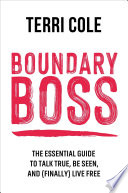
Boundary Boss
Terri ColeThe Essential Guide to Talk True, Be Seen, and (Finally) Live Free
18 min

The concept of boundaries is central to personal and professional relationships. Boundaries define what is acceptable and what is not, allowing individuals to protect their time, energy, and emotional well-being. In 'Boundary Boss', the author emphasizes that setting boundaries is not about being rigid or unyielding; rather, it’s about creating a safe space where individuals can thrive. By understanding the different types of boundaries—physical, emotional, and digital—readers can learn to articulate their needs clearly and assertively. This understanding is the foundation of healthy interactions, enabling individuals to negotiate their limits without guilt or fear of conflict.
Continue readingAssertiveness is a key theme in 'Boundary Boss'. The author discusses the difference between assertiveness, aggression, and passivity. Assertiveness involves standing up for oneself while respecting others, which is crucial when establishing and maintaining boundaries. The book provides practical techniques for developing assertiveness, such as using 'I' statements, maintaining eye contact, and practicing active listening. By becoming more assertive, individuals can communicate their boundaries more effectively, leading to improved relationships both personally and professionally.
Continue readingRecognizing when boundaries are violated is essential for personal empowerment. The author details common signs of boundary violations, such as feelings of resentment, overwhelm, or guilt. By identifying these signs early, individuals can take proactive steps to address the issues before they escalate. The book encourages readers to reflect on their experiences and recognize patterns that may indicate ongoing boundary issues. This self-awareness is crucial for fostering healthier relationships and ensuring that one’s boundaries are respected.
Continue readingSelf-care is intricately linked to boundary setting. The author emphasizes that taking care of oneself is not selfish; rather, it is a necessary component of maintaining healthy boundaries. The book outlines various self-care practices that can help individuals recharge and reinforce their limits, such as mindfulness, journaling, and engaging in hobbies. By prioritizing self-care, individuals are better equipped to assert their boundaries and handle conflicts that may arise when those boundaries are challenged.
Continue readingDifficult conversations often arise when boundaries are tested. The author provides a framework for navigating these conversations effectively, emphasizing the importance of preparation, clarity, and empathy. Readers are encouraged to approach these discussions with a mindset of collaboration rather than confrontation. The book includes strategies for staying calm, listening actively, and expressing one’s needs without escalating tensions. By mastering these skills, individuals can turn challenging interactions into opportunities for growth and understanding.
Continue readingResilience is a recurring theme in 'Boundary Boss'. The author argues that setting and maintaining boundaries is a process that requires strength and perseverance. Readers are encouraged to cultivate resilience by embracing challenges and viewing setbacks as learning opportunities. The book provides tools for developing a resilient mindset, such as reframing negative thoughts and practicing gratitude. By building resilience, individuals can navigate the complexities of boundary setting with confidence and grace.
Continue readingThe book concludes with a call to action for readers to foster a boundary-positive culture in their personal and professional environments. The author discusses the ripple effect of healthy boundary practices, highlighting how they can lead to improved communication, collaboration, and overall well-being. Readers are encouraged to model boundary-setting behaviors and support others in doing the same. By creating a culture that values boundaries, individuals contribute to a more respectful and productive community.
Continue readingThe reading time for Boundary Boss depends on the reader's pace. However, this concise book summary covers the 7 key ideas from Boundary Boss, allowing you to quickly understand the main concepts, insights, and practical applications in around 18 minutes.
Boundary Boss is definitely worth reading. The book covers essential topics including Understanding Boundaries, The Importance of Assertiveness, Recognizing Boundary Violations, providing practical insights and actionable advice. Whether you read the full book or our concise summary, Boundary Boss delivers valuable knowledge that can help you improve your understanding and apply these concepts in your personal or professional life.
Boundary Boss was written by Terri Cole.
If you enjoyed Boundary Boss by Terri Cole and want to explore similar topics or deepen your understanding, we highly recommend these related book summaries:
These books cover related themes, complementary concepts, and will help you build upon the knowledge gained from Boundary Boss. Each of these summaries provides concise insights that can further enhance your understanding and practical application of the ideas presented in Boundary Boss.